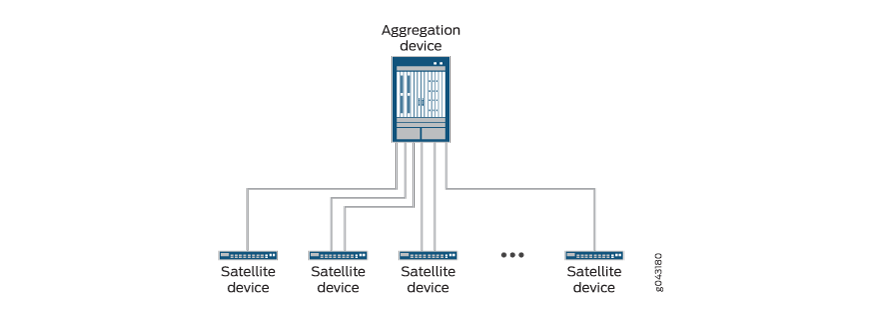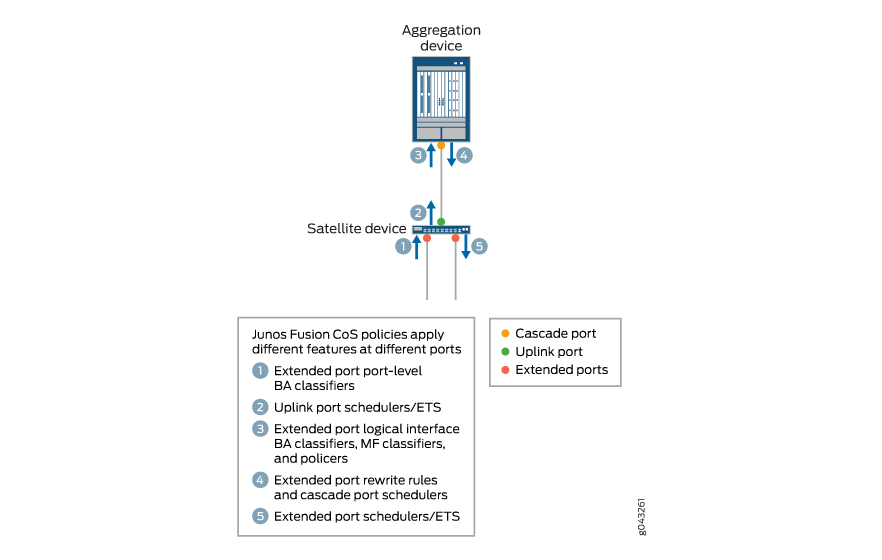Understanding CoS on an MX Series Aggregation Device in Junos Fusion Provider Edge
Junos Fusion provides a method of significantly expanding the number of available network interfaces on an aggregation device by allowing the aggregation device to add interfaces through interconnections with satellite devices. The entire system—the interconnected aggregation device and satellite devices—is called Junos Fusion. Junos Fusion simplifies network administration by appearing in the network topology as a single device, and the single device is managed from a single IP address.
See Figure 1 for an illustration of the Junos Fusion topology.

An aggregation device can be an MX240, MX480, MX960, or MX2020 Universal Routing Platform running a supported Junos OS release.
This topic describes class of service (CoS) on the different types of ports in Junos Fusion.
This topic covers:
Overview of CoS on Different Types of Ports in Junos Fusion
Figure 2 provides an overview of packet flow through Junos Fusion and how CoS features are applied at the different ports.

All configuration for CoS policies for Junos Fusion is done on the aggregation device. For CoS policies that you define for extended ports, however, different portions of that policy are applied at different points in a packet’s path through Junos Fusion. From Figure 2:
As a packet enters an extended port, any port-level (physical interface-level) behavior aggregate (BA) classifier you define for that port is applied to derive a forwarding class and packet loss priority.
As that packet exits the uplink port, you can apply schedulers or enhanced transmission selection (ETS) based on the port-level BA classifier assigned at the ingress extended port.
As the packet enters the aggregation device at the cascade port, any multifield classifiers, policers, or logical interface-level BA classifiers you define for the ingress extended port are applied.
As the packet exits the aggregation device at the cascade port, any rewrite rules you define for the egress extended port, as well as any schedulers you define for the cascade port, are applied, unless the rewrite rule is associated with an extended port logical interface. Also, the forwarding class determined in the previous step is carried in the 801.2BR header to the satellite device and used to select the output queue at the egress extended port.
Finally, as the packet exits an extended port, any schedulers or ETS you define for that port are applied based on the forwarding class determined by the multifield classifiers, policers, or logical interface-level BA classifiers defined for the ingress extended port.
The following sections provide further information about implementing CoS on each port type in Junos Fusion.
CoS on Extended Ports and Uplink Ports in Junos Fusion
All class of service (CoS) scheduling policies for extended ports and uplink ports on the satellite devices are provisioned on the MX Series aggregation device. Similarly, standard Junos OS CoS commands are issued on the MX Series aggregation device for retrieving extended port and uplink port CoS states and queue statistics. The MX Series aggregation device supports configuring the following CoS features for each extended port and uplink port on each satellite device:
Behavior aggregate classifiers
Multifield classifiers
Input and output policers
Forwarding classes
Traffic control profiles
Schedulers and scheduler maps
Per-unit and hierarchical schedulers (extended ports only)
Egress rewrite rules
Configuring CoS policies on satellite devices (on both extended and uplink ports) has the following restrictions:
Fixed classifiers are not supported.
IP precedence classifiers are not supported. DSCP classifiers are supported, however.
The
transmit-rateoption is supported for schedulers. However, theremainder,rate-limit, andexactoptions are not supported undertransmit-rate.-
EX4300 Series devices used in a satellite role support up to two entries per segmented drop profile.
While CoS features for satellite device ports are configured on the aggregation device, the actual classification, queueing, and scheduling is performed on the satellite devices. Information on actual traffic shaping is not passed back to the aggregation device. Logical interface statistics for the show interfaces command are collected on the aggregate device and do not include shaping rate data. For actual traffic statistics gathered on satellite device interfaces, use the statistics for the physical interface and not the logical interface.
You cannot retrieve CoS statistics on extended ports through
an SNMP query. To see CoS statistics on an extended port, use the show interfaces queue interface-name extended-port-interface-name and show interfaces extended-port-interface-name extensive commands.
Per-unit and Hierarchical Scheduling on Extended Ports
Junos Fusion Provider Edge supports per-unit and hierarchical schedulers on extended ports. To support per-unit or hierarchical scheduling on an extended port, all cascade ports on the aggregation device for that extended port must have a queueing chip.
Multihomed satellite devices do not support per-unit and hierarchical scheduling.
To enable per-unit scheduling on an extended port, enable the per-unit-scheduler option at the [edit interfaces interface-name] hierarchy level for the extended
port.
To enable hierarchical scheduling on an extended port, enable
the hierarchical-scheduler option at the [edit interfaces interface-name] hierarchy level for the extended
port.
If you enable hierarchical scheduling on an extended port, you must also explicitly configure schedulers at the interface set or VLAN level.
Junos Fusion treats the cascade ports
connecting the aggregation device to the satellite device as aggregated Ethernet
ports with aggregation done automatically without configuration. By default the
Junos Fusion implementation of hierarchical CoS applies the scheduler parameters
across all cascade ports in scale mode. Because
scale mode divides the configured shaper equally across the
cascade ports, traffic drops can start before a customer reaches its committed rate
for a particular flow.
You
can set all cascade ports on an aggregation device to be in
replicate mode, thereby copying scheduler parameters to each
level of the aggregated interface member links, and automatically target all of an
extended port’s traffic to a specific cascade port. To do this, simply enable
target-mode for the satellite device at the [edit
chassis satellite-management fpc fpc-number]
hierarchy level. For example:
[edit]
user@host# show chassis satellite-management
fpc 100 {
target-mode;
cascade-ports [ xe-0/0/1:0 xe-1/0/0:1 xe-1/0/0:2 xe-1/0/1:1 ];
}
Enabling or disabling target-mode disrupts traffic
on the satellite device while extended ports are deleted and re-added
and cascade ports are reconfigured on the aggregate device.
Broadband Subscriber Services Support
Junos Fusion Provider Edge supports Broadband Edge Subscriber Management, including standard CoS functionality for Broadband Edge Subscriber Management.
BNG on Junos Fusion Provider Edge supports the following CoS scheduling hierarchies:
Dynamic logical interface set/Static-VLAN-Demux/Extended port physical interface
Dynamic logical interface/Extended port physical interface
Dynamic logical interface set/Extended port physical interface
Dynamic logical interface/Dynamic logical interface set/Extended port physical interface
To support 4 levels of hierarchical scheduling (for example,
queue/dynamic logical interface/dynamic logical interface set/extended
port physical interface), you need MPCs on the aggregation device
that support at least 5 levels of hierarchical scheduling. This is
because one level of scheduling is consumed by the cascade port. Every
MPC on the aggregation device configured for Broadband Edge Subscriber
Management must support at least 4 levels of hierarchical scheduling.
Also, the maximum-hierarchy-levels option at the [edit
interfaces interface-name hierarchical-scheduler] hierarchy
for the extended port must be set to one less what the MPC for the
associated cascade port supports because of the one level of scheduling
the cascade port consumes.
Classifiers and rewrite rules are supported on subscriber logical interfaces.
Shaping calculations include the 801.BR overhead bytes.
Multicast is supported through a separate VLAN on the extended port, but multicast is not supported using subscriber dynamic profiles and there is no CoS bandwidth adjustment support for the subscribers.
The show class-of-service scheduler-hierarchy interface command is supported and shows the cascade port as part of the hierarchy. For example:
user@host > show class-of-service scheduler-hierarchy interface demux0.3221225473
Interface/ Shaping Guarnteed Guaranteed/ Queue Excess
Resource name rate rate Excess weight weight
kbits kbits priority high/low
ge-100/0/0(xe-2/0/5) 10000000
ge-100/0/0(xe-2/0/5) RTP
10000000
demux0.3221225473 1000 0 500 500
best-effort 1000 0 Low Low 95
network-control 1000 0 Low Low 5
In the above sample output, ge-100/0/0 is the extended
port and xe-2/0/5 is the cascade port.
CoS Hierarchical Port Scheduling with Enhanced Transmission Selection in Junos Fusion
In Junos Fusion, the satellite device can be either a QFX5100 or an EX4300 device. The QFX5100 supports enhanced transmission selection (ETS), which is described in IEEE 802.1Qaz. Configuration support for ETS has been added to the MX Series device only for satellite device ports that support this feature. If ETS is configured on the MX Series aggregation device for a satellite device port that does not support ETS, the satellite devices converts the ETS configuration to port scheduler.
Local ports on the MX Series aggregation device do not support ETS.
CoS on Cascade Ports in Junos Fusion
When a cascade port is created, two logical interfaces are automatically created:
-
One in-band management logical interface (assigned unit 32769) for traffic that only flows between the aggregation device and the satellite devices, such as keepalives, for provisioning information, and for software updates.
-
One for data logical interface (assigned unit 32770) for regular traffic that flows into and out of Junos Fusion.
Per-unit scheduling is automatically enabled on the cascade port to support multiple queues on each of the logical interfaces.
All cascade ports must be configured on Modular Port Concentrators (MPCs) that support per-unit scheduling.
50 Mbps of bandwidth is reserved for the management logical interface. The remaining bandwidth is available to the data logical interface. A shaping rate of 10 percent is also applied to the management logical interface, which means it can use up to 10 percent of the full interface bandwidth, if available.
The default scheduling policy is applied to the data logical interface. This reserves 95 percent of the available bandwidth and buffer space for the best effort forwarding class (mapped to queue 0) and 5 percent for the network control forwarding class (mapped to queue 3). You can create custom forwarding classes and schedulers by applying a custom scheduler map to this logical interface.
If you are using a custom scheduler map, associate it with a traffic control profile that guarantees a minimum bandwidth of 90 percent. If the minimum guaranteed bandwidth is not configured, the in-band management logical interface will use buffer resources. This can lead to packet loss on the cascade port.
Change History Table
Feature support is determined by the platform and release you are using. Use Feature Explorer to determine if a feature is supported on your platform.
